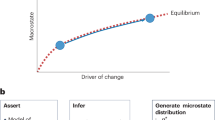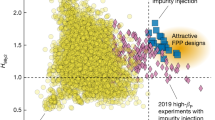Abstract
Massive stars (with mass m* > 8 solar masses M⊙) are fundamental to the evolution of galaxies, because they produce heavy elements, inject energy into the interstellar medium, and possibly regulate the star formation rate. The individual star formation time, t*f, determines the accretion rate of the star; the value of the former quantity is currently uncertain by many orders of magnitude1,2,3,4,5,6, leading to other astrophysical questions. For example, the variation of t*f with stellar mass dictates whether massive stars can form simultaneously with low-mass stars in clusters. Here we show that t*f is determined by the conditions in the star's natal cloud, and is typically ∼105 yr. The corresponding mass accretion rate depends on the pressure within the cloud—which we relate to the gas surface density—and on both the instantaneous and final stellar masses. Characteristic accretion rates are sufficient to overcome radiation pressure from ∼100M⊙ protostars, while simultaneously driving intense bipolar gas outflows. The weak dependence of t*f on the final mass of the star allows high- and low-mass star formation to occur nearly simultaneously in clusters.
This is a preview of subscription content, access via your institution
Access options
Subscribe to this journal
Receive 51 print issues and online access
$199.00 per year
only $3.90 per issue
Buy this article
- Purchase on Springer Link
- Instant access to full article PDF
Prices may be subject to local taxes which are calculated during checkout


Similar content being viewed by others
References
Bernasconi, P. A. & Maeder, A. About the absence of a proper zero age main sequence for massive stars. Astron. Astrophys. 307, 829–839 (1996).
McLaughlin, D. E. & Pudritz, R. E. Gravitational collapse and star formation in logotropic and nonisothermal spheres. Astrophys. J. 476, 750–765 (1997).
Stahler, S. W., Palla, F. & Ho, P. T. P. in Protostars & Planets IV (eds Mannings, V., Boss, A. P. & Russell, S. S.) 327–351 (Univ. Arizona Press, Tucson, 2000).
Behrend, R. & Maeder, A. Formation of massive stars by growing accretion rate. Astron. Astrophys. 373, 190–198 (2001).
Osorio, M., Lizano, S. & D'Alessio, P. Hot molecular cores and the formation of massive stars. Astrophys. J. 525, 808–820 (1999).
Nakano, T., Hasegawa, T., Morino, J.-I. & Yamashita, T. Evolution of protostars accreting mass at very high rates: Is Orion IRc2 a huge protostar? Astrophys. J. 534, 976–983 (2000).
Plume, R., Jaffe, D. T., Evans, N. J. II, Martin-Pintado, J. & Gomez-Gonzalez, J. Dense gas and star formation: Characteristics of cloud cores associated with water masers. Astrophys. J. 476, 730–749 (1997).
Bertoldi, F. & McKee, C. F. Pressure-confined clumps in magnetized molecular clouds. Astrophys. J. 395, 140–157 (1992).
Hillenbrand, L. A. & Hartmann, L. W. A preliminary study of the Orion nebula cluster structure and dynamics. Astrophys. J. 492, 540–553 (1998).
van der Tak, F. F. S., van Dishoeck, E. F., Evans, N. J. II & Blake, G. A. Structure and evolution of the envelopes of deeply embedded massive young stars. Astrophys. J. 537, 283–303 (2000).
Vázquez-Semadeni, E., Ostriker, E. C., Passot, T., Gammie, C. F. & Stone, J. M. in Protostars & Planets IV (eds Mannings, V., Boss, A. P. & Russell, S. S.) 3–28 (Univ. Arizona Press, Tucson, 2000).
Richer, J. S., Shepherd, D. S., Cabrit, S., Bachiller, R. & Churchwell, E. in Protostars & Planets IV (eds Mannings, V., Boss, A. P. & Russell, S. S.) 867–894 (Univ. Arizona Press, Tucson, 2000).
Matzner, C. D. & McKee, C. F. Efficiencies of low-mass star and star cluster formation. Astrophys. J. 545, 364–378 (2000).
McLaughlin, D. E. & Pudritz, R. E. A model for the internal structure of molecular cloud cores. Astrophys. J. 469, 194–208 (1996).
Larson, R. B. Turbulence and star formation in molecular clouds. Mon. Not. R. Astron. Soc. 194, 809–826 (1981).
Stahler, S. W., Shu, F. H. & Taam, R. E. The evolution of protostars. I—Global formulation and results. Astrophys. J. 241, 637–654 (1980).
Crutcher, R. M. Magnetic fields in molecular clouds: Observations confront theory. Astrophys. J. 520, 706–713 (1999).
Jijina, J. & Adams, F. C. Infall collapse solutions in the inner limit: Radiation pressure and its effects on star formation. Astrophys. J. 462, 874–887 (1996).
Shu, F. H. Self-similar collapse of isothermal spheres and star formation. Astrophys. J. 214, 488–497 (1977).
Palla, F. & Stahler, S. W. Star formation in the Orion nebula cluster. Astrophys. J. 525, 772–783 (1999).
Wolfire, M. G. & Cassinelli, J. Conditions for the formation of massive stars. Astrophys. J. 319, 850–867 (1987).
Bonnell, I. A., Bate, M. R., Clarke, C. J. & Pringle, J. E. Competitive accretion in embedded stellar clusters. Mon. Not. R. Astron. Soc. 323, 785–794 (2001).
Palla, F. & Stahler, S. W. The evolution of intermediate-mass protostars. II—Influence of the accretion flow. Astrophys. J. 392, 667–677 (1992).
Nakano, T., Hasegawa, T. & Norman, C. The mass of a star formed in a cloud core: Theory and its application to the Orion A cloud. Astrophys. J. 450, 183–195 (1995).
Palla, F. & Stahler, S. W. The evolution of intermediate-mass protostars. I—Basic results. Astrophys. J. 375, 288–299 (1991).
Schaller, G., Schaerer, D., Meynet, G. & Maeder, A. New grids of stellar models from 0.8 to 120 solar masses at Z = 0.020 and Z = 0.001. Astron. Astrophys. Suppl. 96, 269–331 (1992).
Hunter, T. R. et al. G34.24+0.13MM: A deeply embedded proto-B-star. Astrophys. J. 493, L97–L100 (1998).
Molinari, S., Testi, L., Brand, J., Cesaroni, R. & Palla, F. IRAS 23385+6053: A prototype massive class 0 object. Astrophys. J. 505, L39–L42 (1998).
Kaufman, M. J., Hollenbach, D. J. & Tielens, A. G. G. M. High-temperature molecular cores near massive stars and application to the Orion hot core. Astrophys. J. 497, 276–287 (1998).
Wyrowski, F., Schilke, P., Walmsley, C. M. & Menten, K. M. Hot gas and dust in a protostellar cluster near W3(OH). Astrophys. J. 514, L43–L46 (1999).
Acknowledgements
We thank S. Stahler, R. Pudritz, M. Walmsley and M. Krumholz for discussions. This work was supported by the NSF, by NASA (which supports the Center for Star Formation Studies) and (for J.C.T.) by a Spitzer-Cotsen fellowship from Princeton University.
Author information
Authors and Affiliations
Corresponding author
Rights and permissions
About this article
Cite this article
McKee, C., Tan, J. Massive star formation in 100,000 years from turbulent and pressurized molecular clouds. Nature 416, 59–61 (2002). https://doi.org/10.1038/416059a
Received:
Accepted:
Issue Date:
DOI: https://doi.org/10.1038/416059a
This article is cited by
-
Synthetic observations using POLARIS: an application to simulations of massive prestellar cores
Astrophysics and Space Science (2022)
-
Accretion disks in luminous young stellar objects
The Astronomy and Astrophysics Review (2016)
-
Observational perspective of the youngest phases of intermediate-mass stars
Astrophysics and Space Science (2015)
-
A dark cloud unveils its secrets
Nature (2013)
-
A hot compact dust disk around a massive young stellar object
Nature (2010)
Comments
By submitting a comment you agree to abide by our Terms and Community Guidelines. If you find something abusive or that does not comply with our terms or guidelines please flag it as inappropriate.



